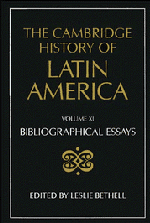Book contents
- Frontmatter
- I THE INDIGENOUS PEOPLES OF MIDDLE AND SOUTH AMERICA ON THE EVE OF THE CONQUEST
- II COLONIAL SPANISH AMERICA
- III COLONIAL BRAZIL
- IV THE INDEPENDENCE OF LATIN AMERICA
- V LATIN AMERICA: ECONOMY, SOCIETY, POLITICS, c. 1820 TO c. 1870
- 1 Post-independence Spanish America: Economy and society
- 2 Post-independence Spanish America: Society and politics
- 3 Mexico
- 4 Central America
- 5 Haiti and the Dominican Republic
- 6 Cuba, c. 1760–c.1860
- 7 Venezuela, Colombia and Ecuador
- 8 Peru and Bolivia
- 9 Chile
- 10 The River Plate republics
- 11 Brazil, 1822–1850
- 12 Brazil, 1850–1870
- VI LATIN AMERICA: ECONOMY, SOCIETY, POLITICS, c. 1870 to 1930
- VII LATIN AMERICA: ECONOMY, SOCIETY, POLITICS, 1930 to c. 1990
- VIII IDEAS IN LATIN AMERICA SINCE INDEPENDENCE
- IX LATIN AMERICAN CULTURE SINCE INDEPENDENCE
- X THE INTERNATIONAL RELATIONS OF LATIN AMERICA SINCE INDEPENDENCE
- THE CAMBRIDGE HISTORY OF LATIN AMERICA
6 - Cuba, c. 1760–c.1860
from V - LATIN AMERICA: ECONOMY, SOCIETY, POLITICS, c. 1820 TO c. 1870
Published online by Cambridge University Press: 28 March 2008
- Frontmatter
- I THE INDIGENOUS PEOPLES OF MIDDLE AND SOUTH AMERICA ON THE EVE OF THE CONQUEST
- II COLONIAL SPANISH AMERICA
- III COLONIAL BRAZIL
- IV THE INDEPENDENCE OF LATIN AMERICA
- V LATIN AMERICA: ECONOMY, SOCIETY, POLITICS, c. 1820 TO c. 1870
- 1 Post-independence Spanish America: Economy and society
- 2 Post-independence Spanish America: Society and politics
- 3 Mexico
- 4 Central America
- 5 Haiti and the Dominican Republic
- 6 Cuba, c. 1760–c.1860
- 7 Venezuela, Colombia and Ecuador
- 8 Peru and Bolivia
- 9 Chile
- 10 The River Plate republics
- 11 Brazil, 1822–1850
- 12 Brazil, 1850–1870
- VI LATIN AMERICA: ECONOMY, SOCIETY, POLITICS, c. 1870 to 1930
- VII LATIN AMERICA: ECONOMY, SOCIETY, POLITICS, 1930 to c. 1990
- VIII IDEAS IN LATIN AMERICA SINCE INDEPENDENCE
- IX LATIN AMERICAN CULTURE SINCE INDEPENDENCE
- X THE INTERNATIONAL RELATIONS OF LATIN AMERICA SINCE INDEPENDENCE
- THE CAMBRIDGE HISTORY OF LATIN AMERICA
Summary
Hugh Thomas, Cuba or the Pursuit of Freedom (London, 1971), is a general history of Cuba since 1762. Raymond Carr, Spain 1808–1939 (Oxford, 1966), is the best general history of Spain for this period. On the Bourbon reforms in Cuba, see Allan J. Kuethe, Cuba, 1753–1815: Crown, Military and Society (Knoxville, Tenn., 1986). Ramiro Guerra y Sanchez, Sugar and Society in the Caribbean: An Economic History of Cuban Agriculture, trans. Marjorie Urquidi (New Haven, Conn., 1964) and Fernando Ortiz, Cuban Counterpoint: Tobacco and Sugar, trans. Harriet de Onís (New York, 1947), are brilliant and suggestive essays by great Cuban writers. Planter society is well analysed in Roland Ely, Cuando reinaba su majestad el azúcar: Estudio histórico-sociológico de una tragedia latinoamericana (Buenos Aires, 1963), a major work of historical reconstruction largely based on the papers of the Drake and Terry families. See also Franklin W. Knight, ‘Origins of wealth and the sugar revolution in Cuba, 1750–1850’, HAHR, 57/2 (1977), 236–53. Laird W. Bergad, Cuban Rural Society in the Nineteenth Century: The Social and Economic History of Monoculture in Matanzas (Princeton, N.J., 1990) is an important provincial study. The sugar industry is best studied from a technical point of view in Manuel Fraginals, El ingenio, 1 (Havana, 1964), Eng. trans. The Sugarmill: The Socioeconomic Complex of Sugar in Cuba 1760–1860 (New York, 1976). The slave trade to Cuba in the nineteenth century, and its abolition, has been adequately covered in David Murray, Odious Commerce: Britain, Spain and the Abolition of the Cuban Slave Trade (Cambridge, Eng., 1980), while the Spanish side of the abolition of both the slave trade and slavery has been analysed in Arthur F. Corwin, Spain and the Abolition of Slavery in Cuba 1817–1886 (Austin, Tex., 1967).
- Type
- Chapter
- Information
- The Cambridge History of Latin America , pp. 272 - 274Publisher: Cambridge University PressPrint publication year: 1995



